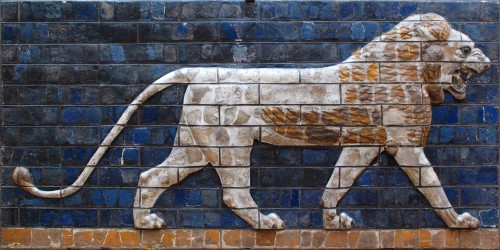In 225 B.C.E., the Greek writer Philo of Byzantium wrote On The Seven Wonders, and this early literary work highlighted the greatest man-made entities at the time. Most of the seven ancient wonders of the world are still shrouded in mystery and beauty. Yet, when it comes to these ancient wonders, the most mysterious is the hanging gardens of Babylon.
The Seven Wonders of the Ancient World are the Great Pyramid of Giza, the Statue of Zeus at Olympia, the Temple of Artemis at Ephesus, the Mausoleum at Halicarnassus, the Colossus of Rhodes, and the lighthouse at Alexandria. The Hanging Gardens, the last Ancient Wonder of the world, called Babylon its home. Babylon rose to power for the second time from 600 to 550 B.C.E., as the Chaldean Empire under the reign of King Nebuchadnezzar. His kingdom grew to be thousands of miles wide, and King Nebuchadnezzar secured his capital city of Bablyon with large walls. These protective walls were believed to be multiple feet thick and impenetrable.1
On these walls were beautiful shrubs and flowers. The legend of how these flowers bloomed over the wall began with the king. Nebuchadnezzar was proud of his creation, but one of his wives still longed for more. She mourned for her homeland on top of a mountain and wished to see the beauty of her home once again. When the king heard this, he ordered for the flowers and shrubs to be brought and then placed on top of his great wall. Exotic flowers and greenery brought a wonderful fragrance to the kingdom. The walls were irrigated using new technology. Waterwheels and pumps were installed, truly making the gardens a scientific and artistic masterpiece.2

What we can know about the Hanging Gardens of Babylon is one the most challenging of projects for modern scholars. This is due to the lack of evidence that we have about whether these gardens ever even existed in Babylon so many thousands of years ago. Much of the literature on the Hanging Gardens was written by second-hand accounts in the ancient world. Historians and archaeologists have searched for the gardens in the ruins of Babylon, but nothing concrete has been found. There are many theories about the actual location of the gardens; the leading theory comes from scholar Stephanie Dalley, a researcher from Oxford University in England. She believes that the Hanging Gardens were not in Babylon at all, but rather in Nineveh.
Dalley is an expert in ancient Mesopotamian languages. The new translations of texts from the reign of King Sennacherib of Nineveh state that there was a large beautiful garden in Nineveh that was irrigated by an aqueduct. The texts describe a water-raising screw made of bronze. The descriptions resemble that of other ancient writers’ descriptions of the Hanging Gardens, and as such, there could have been a misunderstanding in translation in subsequent years. Dalley explains that the conquering of Babylon by the Assyrians gave them the nickname of Nineveh or “New Babylon.”3
The Seven Ancient Wonders of the World still have many mysteries connected to them. Yet, the most mysterious is that of Babylon’s Hanging Gardens. Many have been skeptical that they may have never existed. Now, new evidence brings hope that more about the Gardens may yet be known, and a new understanding of the wonder of ancient civilizations may come to light.4
- Jerry Bentley, Herbert F. Zieglar, and Heather E. Streets, Traditions and Encounters, a Brief Global History. 4th ed. Vol. 1. (Boston: McGraw Hill Higher Education, 2008), 12. ↵
- Ancient History Encyclopedia, 2009, s.v. “The Seven Wonders,” by Joshua J. Mark. ↵
- Stephanie Dalley, “Garden History,” Ancient Mesopotamian Gardens and the Identification of the Hanging Gardens of Babylon Resolved, vol. 21, (February 2009): 7. ↵
- Stephanie Dalley, “Garden History,” Ancient Mesopotamian Gardens and the Identification of the Hanging Gardens of Babylon Resolved, vol. 21, (February 2009): 7. ↵



44 comments
Michael Hinojosa
It’s kind of wild to hear about these kind of ancient stories only to find out that they actually exist in real life! Almost like a kind of fantasy turned reality thing to me as I never really thought that these hanging gardens actually existed at all! And if they did exist I certainly expected them to be in Babylon, unlike where they actually turned out to be of course.
Tala Owens
It’s crazy how beautiful structures like the seven wonders of the world came to be and no one really knows how or why or where some of them are. The Hanging Gardens of Babylon were apparently never found but research says it was because it was probably not in Babylon at all. The world has come such a long way and were just now discovering all of its mysteries.
Yazmin Garza
I can not imagine how beautiful the gardens must have been, and how great the air in the smelled because of all the flowers and other flora in the gardens. Every day must have felt like a perfect spring day. It is a shame no one has ever found it. I hope Stephanie Dalley’s hunch about the location of the Hanging Gardens has some truth behind it because if the Hanging Gardens are ever discovered in my lifetime, visiting the ruins will shoot straight to the top of my bucket list.
Mariah Cavanaugh
How interesting that in an attempt to track down the mysterious hanging gardens of Babylon Stephanie Dalley found that the gardens were not in Babylon at all. As we know, stories get told from generation to generation and along the way details get lost. A version of that seems to have taken place in regard to the hanging gardens and their existence.
Angel Torres
The Seven Wonders of the Ancient world all have great meaning and mystery behind them. Unfortunately, due to a lack of evidence regarding the hanging gardens of Babylon, scholars have a difficult time finding out if the hanging gardens of Babylon even existed. Overall the article was very informative and I liked how it incorporated the story behind how the garden was created and how it also incorporated theory on what happened to the garden.
Raymond Nash Munoz III
This article amazingly emulates the idea that a great story can be told in few words. There are certain stories that require many details, which involves lots of words and paragraphs, but there are also stories that just need to get straight to the point. That is where I found the greatest strength and the most interest in this article, the author unfolding the story in a straight forward format that tells the reader something they didn’t know and keeping them interested. In general, this article is a great starting point for anyone unfamiliar with the Hanging Gardens of Babylon.
Diego Aguilera
I didn’t know very much about the Seven Wonders of the World. Reading your article gave me a lot of good information about them, and definitely made me want to look more into the topic. I will continue to do research as I hope one day to visit some if not all of them. Great article overall. Its also interesting to see how many believe the garden is in another location or believe that its myth since the gardens have not actually been found.
Nathan Hartley
I think it is absolutely astonishing that the engineers of the the time period were able to figure out the technology required to build this. The beauty and the innovation for the time period are more than enough to make it one of the seven wonders of the world, and someday I would love to see it re-created in its full glory.
Jose Fernandez
I found your article very interesting! Even though it isn’t long, I learned a lot about the topic. I had heard about the Hanging Gardens of Babylon but I didn’t know much about them. I always like reading about mysteries and this wasn’t the exception. I just hope that historians and scientists keep finding research so we can know more about the gardens. The article was very clear and structured.
Diego Aguilera
I didn’t know very much about the Seven Wonders of the World. Reading your article gave me a lot of good information about them, and definitely made me want to look more into the topic. I will continue to do research as I hope one day to visit some if not all of them. Great article overall